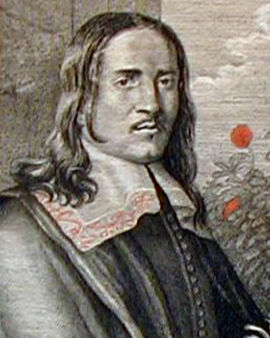Jan van Kessel the Elder or also Jan van Kessel I came from a great dynasty of painters. On his father's side he descended from Hiernonymus van Kessel and his mother was a daughter of Jan Brueghel the Elder. This also made him the great-grandson of Pieter Brueghel, the nephew of Jan Brueghel the Younger and the nephew of David Teniers the Younger. The family sent him to Simon de Vos as an apprentice when he was 9 years old. His further education then took place largely within the family.
Van Kessel was a very versatile artist who tried his hand in many different genres. He painted still lifes, animal pictures, allegorical scenes but also various landscape motifs. He was inspired by his grandfather Jan Brueghel the Elder and other Flemish painters like Daniel Seghers, Joris Hoefnagel and Frans Snyders. He was also very active in the genre of garland painting, which was founded by his grandfather Jan Brueghel, among others. Together with his uncle David Teniers, for example, he worked on the painting "The Soap Bubbles", in which he painted the decorative flower garlands around the portrait. As a flower painter he was officially admitted to the Luke Guild of Antwerp in 1644. Two years later he married Maria van Apshoven, with whom he had 13 children. Of his children, two sons, Jan van Kessel the Younger and Ferdinand van Kessel, were also successful painters and were trained by him personally. During van Kessel's lifetime there were thus a total of three painters with the same name. This later caused some confusion when it came to classifying the works. Besides his son Jan, there was another Flemish painter with the same name. However, there was no relation to this one. Another difficulty was that van Kessel used different signatures. He often painted very small pictures on which he could not have placed his otherwise so embellished signature. For a long time it was assumed that because of the different signatures it must have been different artists. Today, his works from 1648 to 1676 can be safely classified.
Van Kessel was a painter obsessed with detail. Especially his still lifes and animal motifs, including various insect studies such as "Still Life Study of Insects on a Rosemary Branch" were of almost scientific accuracy. This made his works very popular throughout Europe. Van Kessel could charge good prices and sell many paintings. This enabled him and his family to live a good, secure life. However, after the death of his wife in 1678, the financial situation deteriorated increasingly. Van Kessel was too old and too ill to be able to paint. He was finally forced to mortgage his house. He died at the age of 53 and left behind a large mountain of debts.
×





 - (MeisterDrucke-266274).jpg)
 - (MeisterDrucke-266274).jpg)
 - (MeisterDrucke-283879).jpg)
 - (MeisterDrucke-283879).jpg)
.jpg)
.jpg)
 - (MeisterDrucke-110324).jpg)
 - (MeisterDrucke-110324).jpg)
.jpg)
.jpg)
 - (MeisterDrucke-64504).jpg)
 - (MeisterDrucke-64504).jpg)
.jpg)
.jpg)
 - (MeisterDrucke-267696).jpg)
 - (MeisterDrucke-267696).jpg)
 - (MeisterDrucke-85933).jpg)
 - (MeisterDrucke-85933).jpg)
 - (MeisterDrucke-239635).jpg)
 - (MeisterDrucke-239635).jpg)
 - (MeisterDrucke-75157).jpg)
 - (MeisterDrucke-75157).jpg)
 - (MeisterDrucke-89342).jpg)
 - (MeisterDrucke-89342).jpg)
 - (MeisterDrucke-62270).jpg)
 - (MeisterDrucke-62270).jpg)
.jpg)
.jpg)
.jpg)
.jpg)
 - (MeisterDrucke-94771).jpg)
 - (MeisterDrucke-94771).jpg)
 - (MeisterDrucke-110223).jpg)
 - (MeisterDrucke-110223).jpg)
.jpg)
.jpg)
 - (MeisterDrucke-76258).jpg)
 - (MeisterDrucke-76258).jpg)
.jpg)
.jpg)
.jpg)
.jpg)
 - (MeisterDrucke-215481).jpg)
 - (MeisterDrucke-215481).jpg)
.jpg)
.jpg)
.jpg)
.jpg)
.jpg)
.jpg)
 - (MeisterDrucke-270250).jpg)
 - (MeisterDrucke-270250).jpg)
 - (MeisterDrucke-55114).jpg)
 - (MeisterDrucke-55114).jpg)
 - (MeisterDrucke-177640).jpg)
 - (MeisterDrucke-177640).jpg)
.jpg)
.jpg)
 - (MeisterDrucke-243479).jpg)
 - (MeisterDrucke-243479).jpg)
.jpg)
.jpg)
 - (MeisterDrucke-58932).jpg)
 - (MeisterDrucke-58932).jpg)
 - (MeisterDrucke-138802).jpg)
 - (MeisterDrucke-138802).jpg)
.jpg)
.jpg)
_-_(MeisterDrucke-376692).jpg)
_-_(MeisterDrucke-376692).jpg)
.jpg)
.jpg)
.jpg)
.jpg)
 - (MeisterDrucke-95443).jpg)
 - (MeisterDrucke-95443).jpg)
 - (MeisterDrucke-290913).jpg)
 - (MeisterDrucke-290913).jpg)
.jpg)
.jpg)
.jpg)
.jpg)
.jpg)
.jpg)
.jpg)
.jpg)
_-_(MeisterDrucke-209793).jpg)
_-_(MeisterDrucke-209793).jpg)
 - (MeisterDrucke-62659).jpg)
 - (MeisterDrucke-62659).jpg)
.jpg)
.jpg)
.jpg)
.jpg)
 - (MeisterDrucke-41817).jpg)
 - (MeisterDrucke-41817).jpg)
.jpg)
.jpg)
.jpg)
.jpg)
.jpg)
.jpg)
_-_(MeisterDrucke-570584).jpg)
_-_(MeisterDrucke-570584).jpg)
.jpg)
.jpg)
.jpg)
.jpg)
.jpg)
.jpg)
.jpg)
.jpg)
.jpg)
.jpg)
.jpg)
.jpg)
 - (MeisterDrucke-92620).jpg)
 - (MeisterDrucke-92620).jpg)
.jpg)
.jpg)
.jpg)
.jpg)
.jpg)
.jpg)
.jpg)
.jpg)
.jpg)
.jpg)
.jpg)
.jpg)
 - (MeisterDrucke-72772).jpg)
 - (MeisterDrucke-72772).jpg)
.jpg)
.jpg)
.jpg)
.jpg)
.jpg)
.jpg)
.jpg)
.jpg)
.jpg)
.jpg)
 - (MeisterDrucke-99838).jpg)
 - (MeisterDrucke-99838).jpg)
.jpg)
.jpg)
.jpg)
.jpg)
.jpg)
.jpg)
.jpg)
.jpg)
.jpg)
.jpg)
.jpg)
.jpg)
.jpg)
.jpg)
.jpg)
.jpg)






